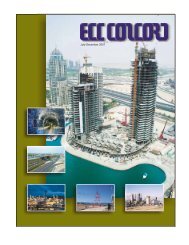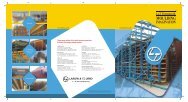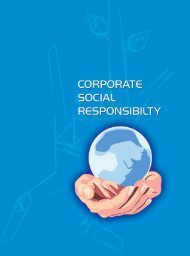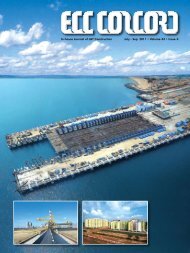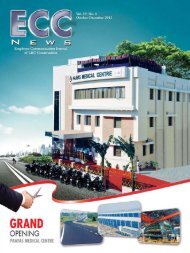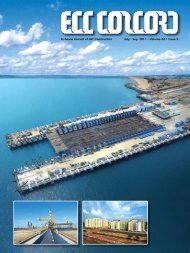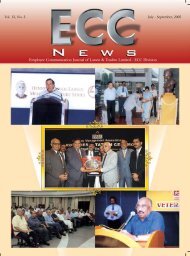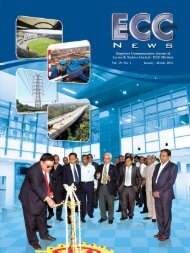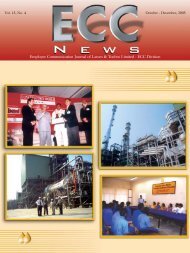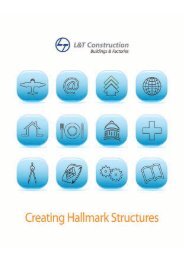Oct - Dec 2009 • Vol. No. 32 Issue No. 2 • - L&T Construction
Oct - Dec 2009 • Vol. No. 32 Issue No. 2 • - L&T Construction
Oct - Dec 2009 • Vol. No. 32 Issue No. 2 • - L&T Construction
Create successful ePaper yourself
Turn your PDF publications into a flip-book with our unique Google optimized e-Paper software.
object of design. It is for the designers to reconcile the appropriate project location can reduce the need for<br />
desire to save costs with the requirements of efficiency private automobile use and reduce urban sprawl.<br />
and well being.<br />
It is also important to minimize project impacts on<br />
The term "green building" is synonymous with `high- surrounding areas after construction is complete<br />
performance building', `sustainable design and and the building is occupied. Addressing heat<br />
construction' as well as other terms that refer to a island effects and reducing light pollution on the site<br />
holistic approach to design and construction. are also vital. Only then, the site can become<br />
integrated into its surroundings and serve as a<br />
Green building design includes all players in an<br />
integrated development process, from the design<br />
team (building owners, architects, engineers and<br />
consultants), the construction team (material<br />
manufacturers, contractors and waste haulers),<br />
maintenance staff, and building occupants. The<br />
green building process results in a high-quality<br />
considerate and beneficial neighbor for the life time<br />
of the building and minimize the impact on micro-<br />
climate, on human life and wildlife. These initiatives<br />
help conserve existing natural areas and restore<br />
damaged areas to provide habitat and promote<br />
biodiversity.<br />
product that maximizes the owner's return on An ideal Green Building aims at limiting disruption<br />
investment. of natural water flows by eliminating storm-water<br />
runoff, increasing on-site infiltration and<br />
Why design green?<br />
eliminating contaminants. It may also be possible to<br />
reuse storm-water for non-potable water purposes<br />
It is common knowledge that the building sector has a such as flushing urinals and toilets, custodial<br />
tremendous impact on the environment. It consumes<br />
more than 30% of our total energy. Buildings are a<br />
applications, and building equipment uses.<br />
major source of the pollutants that cause urban air It is helpful to perform a water balance to determine<br />
quality problems and contribute to climate change. the estimated volumes of water available for reuse.<br />
Storm-water run-off volumes can also be reduced by<br />
Green building practices can substantially reduce designing the building with underground parking, a<br />
such negative environmental impacts associated with<br />
buildings and reverse the trend of unsustainable<br />
strategy that reduces heat island effects significantly.<br />
construction activities. But, that is only part of the Energy consumption can be dramatically reduced<br />
story. Green design also reduces operating costs, through practices that are economical and readily<br />
enhances building marketability, potentially achievable. Improving the energy efficiency of<br />
increases occupant productivity, and helps create a buildings lowers operation costs and reduces<br />
sustainable community.<br />
pollution. Reduction of energy loads through<br />
improved glazing, insulation, day lighting and use of<br />
As of today, there are but a handful of green buildings passive solar features may allow the design team to<br />
in India. With 56 points, this building now stands as<br />
third greenest in India under LEED NC (New<br />
downsize mechanical HVAC systems.<br />
<strong>Construction</strong>) Category and the first LEED Platinum Designing and specifying the use of on-site non<br />
rated project in Gujarat!<br />
polluting renewable technologies can contribute to<br />
the total energy requirement of the project.<br />
Salient features of the 'green'<br />
building:<br />
The architects of this building have studied the norms<br />
for achieving a high level of sustainability in the<br />
architecture of the building. Selection of an<br />
Considering and employing high temperature solar,<br />
geothermal, wind, biomass (other than unsustainably<br />
harvested wood) and bio-gas technologies, are other<br />
green measures.<br />
Photo-voltaics (PVs) are composite materials that<br />
convert sunlight directly into electrical power. In the<br />
13<br />
ECC Concord <strong>Oct</strong>-<strong>Dec</strong> 09



